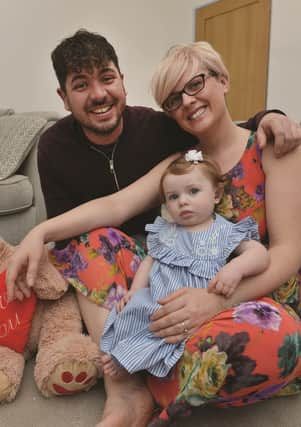VIDEO: Parents’ pride as baby Primrose is picked as deaf magazine’s cover star


The 11-month old was born profoundly deaf, which came as a “big shock” for the first-time mum and her partner Joseph Richardson (29).
But “happy and smiley” Primrose has taken it all in her stride and started using sign language at just seven months old.
“That’s quite advanced,” said Nadine (38).
Advertisement
Hide AdAdvertisement
Hide Ad“They normally don’t pick it up until they’re about a year old, but because we started doing it early, she started doing it early.”
The Thurcroft tot has now become the cover star of the National Deaf Children’s Society’s spring magazine after the parents shared their story about how they are adjusting to their new life.
Doctors discovered Primrose was profoundly deaf in both ears not long after she was born when she failed her hearing screening in hospital.
“But at first they weren’t sure if it was because she had fluid in her ears because she was born by Caesarean section,” said Nadine.
Advertisement
Hide AdAdvertisement
Hide AdBut after further tests, it was confirmed at four weeks old that Primrose was deaf.
“It was completely new to us, we haven’t got anyone in the family that’s deaf,” said Nadine. “It was a really big shock - it was scary.
“We were gutted at first but since then we have embraced it and it’s opened up a whole other world.
“We’ve made lots of new friends, joined loads of new groups and we’re learning a whole new language.
Advertisement
Hide AdAdvertisement
Hide Ad“It’s still scary but I think there’s a lot more deaf awareness compared to what there was 20 years ago.”
Primrose currently has a hearing aid but has been referred for a cochlear implant, which will provide a sensation of hearing.
This means she will be able to hear some sounds, but not all those that make up human speech.
Instead of making the sound louder, like a hearing aid, implants use electrical signals to directly stimulate the auditory nerve (the nerve that carries sound from the cochlea to the brain) and provide access to the range of sounds that make up speech.
Advertisement
Hide AdAdvertisement
Hide Ad“It’s going to be a long slog,” said Nadine. “She’s going to have to have speech therapy but she’s quite vocal so I don’t think she’ll struggle.”
As well as learning to hear and speak with cochlear implants, Primrose’s parents also believe it’s important for her to learn sign language so she can communicate with as many people as possible.
Nadine, Joseph and his mother, Monique Furniss, are all learning British Sign Language at free weekly sessions in Kimberworth and are passing on tips to the rest of their family.
“Primrose can do ‘butterfly’, she can wave, she can do ‘okay’, she can say when she’s hungry and wants her bottle,” said Nadine.
Advertisement
Hide AdAdvertisement
Hide Ad“She’s such a happy and smiley baby, she smiles and waves at everybody.
“It was lovely seeing her in the magazine, I’m so proud of her.
“I know everybody says their baby is clever, but she really is — I don’t think she is going to let being deaf hold her back and we’re not going to let it hold her back either.”
Joseph said: “Our hopes for Primrose in the future are the same as any parent, that she’s able to enjoy life, have fun, appreciate the gift of life — not see being deaf as having a disability.”